
 |
Tea Clipper |
 |
| from TeaAntiques.com | ||
| Edition Six |
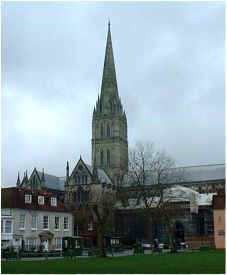 This
month we visit the quaint Cathedral City of Salisbury, in Wiltshire, England. A
beautifully compact city, with many things to interest the tourist. There is a
lovely market square, situated by the Guildhall in the town centre. Here, on a
Saturday there is a good traditional market selling all kinds of fruit,
vegetables, fish, meats, plants and clothing. In a addition there is a caravan
which is run by the local Women's Institute, here can be found a fantastic array
of home made goodies such as Jams, Pickles, Chutneys and cakes, etc. This is
something I like to head for on market day to stock up on delicious chutneys and
jams. A personal recommendation is their Runner Bean chutney, it is fantastic.
It's also a great place to buy your home made cakes for that afternoon tea at
home, or in you hotel room!
This
month we visit the quaint Cathedral City of Salisbury, in Wiltshire, England. A
beautifully compact city, with many things to interest the tourist. There is a
lovely market square, situated by the Guildhall in the town centre. Here, on a
Saturday there is a good traditional market selling all kinds of fruit,
vegetables, fish, meats, plants and clothing. In a addition there is a caravan
which is run by the local Women's Institute, here can be found a fantastic array
of home made goodies such as Jams, Pickles, Chutneys and cakes, etc. This is
something I like to head for on market day to stock up on delicious chutneys and
jams. A personal recommendation is their Runner Bean chutney, it is fantastic.
It's also a great place to buy your home made cakes for that afternoon tea at
home, or in you hotel room!
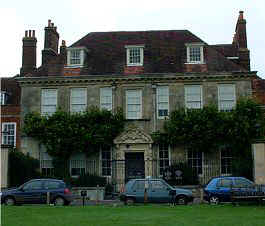 As
well as a good variety of small shops, there are many buildings of historical
interest to visit. In this news letter, I am reviewing Mompesson House, situated
in the Cathedral Close, just a 10 minute walk from the market square, easy to
find being dominated by the elegant and very tall spire of the Cathedral.
As
well as a good variety of small shops, there are many buildings of historical
interest to visit. In this news letter, I am reviewing Mompesson House, situated
in the Cathedral Close, just a 10 minute walk from the market square, easy to
find being dominated by the elegant and very tall spire of the Cathedral.
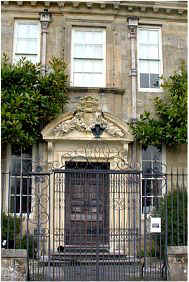 Mompesson
House is administered by the National Trust and is open to the public throughout
the summer months. It is a truly magnificent, comparatively small house, in
which one feels quite at home when looking round it.
Mompesson
House is administered by the National Trust and is open to the public throughout
the summer months. It is a truly magnificent, comparatively small house, in
which one feels quite at home when looking round it.
The house is certainly one of the finest examples of an eighteenth century house to be found in Cathedral Close. The house as we see it, dates from 1701. The dramatic facade is faced with imposing grey limestone, quarried locally from the Chiltern Hills. The effect of the intricate carving can be appreciated in the pediment above the front door, with its fine cartouche with rich floral embellishments.
To step inside this lovely house is an absolute joy, the large, light, airy hall, has some very fine eighteenth century plasterwork. To the right of the hall, is a dining room which contains a rectangular dining table set for dinner on a fine white damask cloth. The drinking glasses on the table, are of drawn trumpet form dating from the early part of the eighteenth century.
Drinking glasses are certainly the thing to view in this property, it houses an extensive and very fine collection of wine glasses. Displayed in cabinets, which chronologically shows the design of wine glasses throughout the Georgian period. These really are a joy to behold, but being so numerous, one tends to skim past them without paying them the intent investigation that they truly deserve.
On the opposite side of the hall to the dining room, is the drawing room. Decorated with very rich red walls and hung with a sparkling crystal chandelier, the room feels remarkably cosy. It benefits from a charming view of the walled garden, situated at the rear of this magnificent house. In this room there is something for the tea antique lover. Situated in front of a comfortable Georgian camel backed settee proudly stands a sofa table, on which is a silver tray set for afternoon tea. The most remarkable item on the table being a rococo silver spirit kettle on stand. This would certainly be a grand item on any tea table. This is complimented by a melon shaped silver three piece teaset. There is also a wooden two compartment tea caddy with central glass mixing bowl on the table. What better place could one wish to sit and enjoy a relaxed afternoon tea, but unfortunately we are not allowed! However, it is possible to enjoy tea in the delightful walled garden, (reviewed below).
After passing through the adjacent little drawing room, one emerges into the
hall again to climb the intricately carved wooden staircase, with its turned
balusters, to the first floor rooms. It is worth taking time to climb the
stairs, in order to admire the superb eighteenth century plaster work. This
really is stunning, and not really to be expected in a house of this modest
proportion. It is also worth pausing on the half landing to catch a view of the
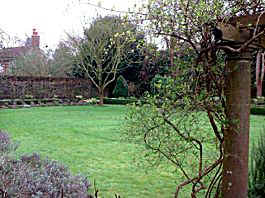 garden, with its lawn and herbaceous boarders.
garden, with its lawn and herbaceous boarders.
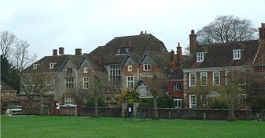 From the
top of the stairs, the visitor enters the green room, from hear there are views
of the Cathedral and the Close. There are some very handsome pieces of good
quality English eighteenth century furniture to be seen in this room,
particularly the walnut bureau and dining chairs.
From the
top of the stairs, the visitor enters the green room, from hear there are views
of the Cathedral and the Close. There are some very handsome pieces of good
quality English eighteenth century furniture to be seen in this room,
particularly the walnut bureau and dining chairs.
The other room upstairs open to the visitor is the front bedroom with its four poster bed and a rather ingenious metamorphic dressing table! A most functional item for the eighteenth century lady.
Returning down stairs, there is one more room to visit situated at the rear of the house behind the dining room. Here there is a gas 'coal effect' fire burning in the grate and walls lined with books. It is a comfortable room where guests are encouraged to sit and enjoy the surrounding, or read some of the available magazines.
Before leaving, one emerges from the back door into the pretty walled town garden with its central part laid to lawn and surrounded by herbaceous boarders, which in the summer months are a blaze of colour. In the far corner of the garden is a small 'summer house' style tea parlour, the final treat!
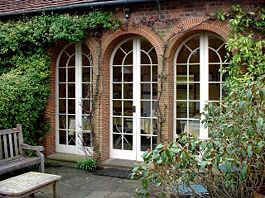 With a
visit to Mompesson House, my recommendation for tea is in the tea parlour set in
the corner of the walled garden. Although this is a rather small establishment,
the surroundings more than make up for it. In the good weather, there are a
number of tables set out on the terrace, here one can sit, relax and enjoy the
views of the garden and the red brick rear aspect of the house.
With a
visit to Mompesson House, my recommendation for tea is in the tea parlour set in
the corner of the walled garden. Although this is a rather small establishment,
the surroundings more than make up for it. In the good weather, there are a
number of tables set out on the terrace, here one can sit, relax and enjoy the
views of the garden and the red brick rear aspect of the house.
As well as tea, a selection of sandwiches, cakes and scones are on offer. There is a lovely tranquillity about sitting out in this garden, snugly tucked away from the hurly burly of the market town.
Treat your self to a visit, and don't forget to take some of the Women's Institute (now called the Country Market) cakes home with you from the market before you leave Salisbury.
From the 17th century, there is a record of a sort of a nourishing brew made from tea as follows:
'To a near pint of the infusion, take 2 egg yolks from new laid eggs, and beat them very well with as much fine sugar as is sufficient for the quantity of liquor. When they are well incorporated, pour your tea upon the eggs, and stir them well together. So drink it hot. This is for when you come home from attending business abroad, and are hungry, and yet have not the convenience to eat, presently a competent meal'
(Extract taken from 'Seven hundred years of English Cooking', by Maxime McKendry)
Anybody fancy trying it out!?
To review past newsletters, just follow this link:
Past newsletters.
To subscribe to this free newsletter -
Click here